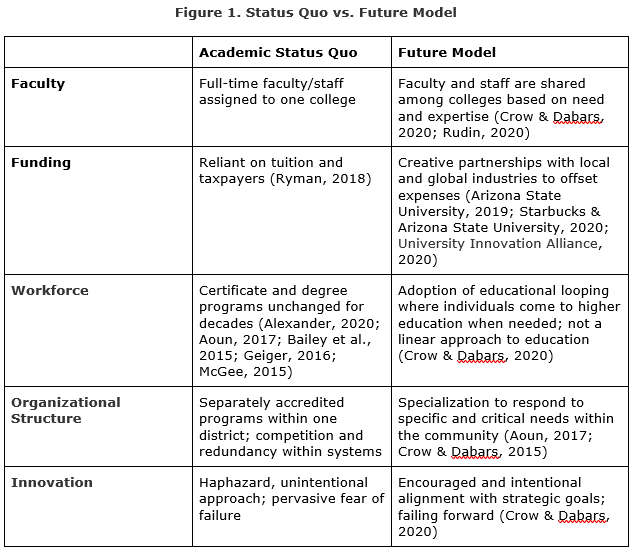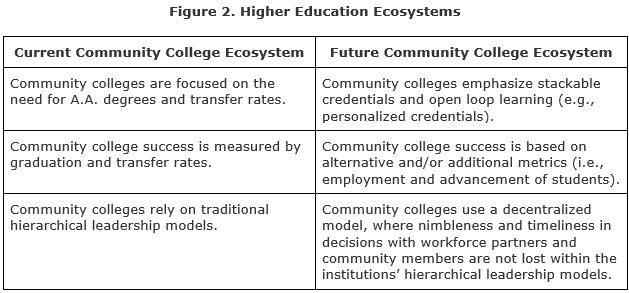What’s Next for Community Colleges? Leadership After COVID-19

In 2008, during a televised event, then White House Chief of Staff Rham Emanuel said, “You never want a serious crisis to go to waste. And what I mean by that is an opportunity to do things that you think you could not do before” (Emanuel, 2008, 0:04). Many articles have been written about the crises the U.S. postsecondary education ecosystem faces regarding relevance, funding, and innovation, all of which demand swift action (Alexander, 2020; Cristensen & Eyring, 2011; Crow & Dabars, 2015; Grawe, 2018; McGee, 2015, Phelan, 2014). However, for many colleges, change has not come quickly enough, and the COVID-19 pandemic forced institutions of higher education into reactive mode. Furthermore, the effects of the pandemic have been most acutely felt by community colleges and the students and communities they serve. So, has higher education let a serious crisis go to waste, or are there opportunities to change how we function to better serve our communities based on what we’ve learned in the past few years?
Long before the pandemic, Christensen and Eyring (2011) called for disrupting higher education. According to the Clayton Christensen Institute (n.d.),
Disruptive innovation describes a process by which a product or service initially takes root in simple applications at the bottom of a market—typically by being less expensive and more accessible—and then relentlessly moves upmarket, eventually displacing established competitors. (para. 1)
An often used example of disruptive innovation is the introduction of the cell phone and its impact on landline usage (Clayton Christensen Institute, n.d.). While the concept of disruption was originally conceived in the business arena, disruptive innovation in higher education can help to propel institutions out of the status quo and provide new ways of meeting the needs of local communities (Christensen et al., 2011; Wain et al., 2018). Ideally, as a result of disrupting higher education, institutional leaders will be more likely to adapt to the changing internal and external environment.
Problem/Issue
No one was prepared for, nor spared from, the global pandemic which began in late 2019 and continues into 2022. As colleges return to a sense of normalcy, leaders should be questioning what the institution should look and feel like (Blumenstyk, 2020a; Blumenstyk, 2020b; Carapezza, 2020). COVID-19 pushed higher education into the 21st century, forcing disruptive innovation into nearly every aspect of the work being done (Bliss, 2021; Christensen & Eyring, 2011). While the pivot may not have been as difficult for institutions already using 21st century technology, for many it was a dramatic shift. Regardless of where each institution started, the questions we all need to be asking ourselves now are, how do institutions move forward; what quickly adopted practices should be kept or discarded; and what will the “better normal” be for employees, institutions, and communities?
Research
The author’s doctoral research focused on change and disruption through an entrepreneurial mindset. Figure 1 identifies the macro areas of study, comparing the current status quo at Mesa Community College and ways community colleges could adapt for the future. Although the data was focused on faculty members, a literature review and accompanying research provided information about qualities and/or attributes leaders should have to move their institutions forward.

The author used three personality- and skill-based attributes to frame the survey questions asked of faculty respondents: risk taker, action taker, and future focused. These traits were chosen based on the work from Bacigalupo et al. (2016) and the development of a measure of an entrepreneurial mindset by Davis et al. (2015). The author’s intent was to discover what had changed for faculty as a result of the pandemic (e.g., their understanding of risk taking). The following five findings were identified by this research:
- Females responded more positively for understanding and operationalizing risk taking.
- Females responded more positively than males in terms of understanding and being able to operationalize concepts of responding to community needs and partnerships.
- Participants choosing not to identify their ethnicity/race scored more negatively for the entrepreneurial mindset concept of taking action (specifically, change and the amount of change).
- An inverse relationship with age was significant. Older participants were less positive about entrepreneurial mindset attributes, particularly regarding taking action, both in their understanding and operationalization.
- Although not statistically significant, there was a negative correlation with the entrepreneurial mindset of taking action as years of service increase.
These key findings coupled with the literature regarding entrepreneurial mindset, innovation, and leadership competencies led to the following recommendations for the future of community colleges.
Recommendations for Future Leaders
The first recommendation is to rethink how education is perceived, replacing the status quo with the creation of stackable credentials in an open looped learning model, particularly for career and technical education programs (Corbin & Thomas, 2019; deLaski & Glasper, 2021; DeRue, 2018). Traditionally, education is viewed from a linear perspective. However, in a pilot by Stanford University (2021), researchers discovered that by providing students six years to complete their educational goals and allowing them to enroll only as needed, there was greater connection and commitment to both the institution and the students’ goals (Stanford University, 2021a, 2021b). In community colleges, many students take longer than the two years typically identified as being the length of time it takes to complete associate degrees (Bailey et al., 2015; Claggett, 2011; Jenkins & Cho, 2013; Maricopa Community Colleges, 2020). The extended time to complete is not intentional; often, students’ life circumstances interrupt their forward progress. Instead of viewing students negatively for taking longer than two years to complete, community colleges should build in the extra time for completion. For example, when students’ educational journeys are interrupted, institutions can make things as easy as possible for them to come back. Solutions could include staff reaching out to students when they have missed one semester to attempt to connect them with the college again, advisors preparing their return plan before the student leaves the college, the college keeping stopped-out student profiles active for a longer period of time to make it easier for students to access their accounts, and institutions relying on AI to help with some of this work.
The second recommendation is to establish a discovery and solution incubator within community college campuses. All aspects of our educational system from K-12 up have been impacted by the pandemic, but how much time has been intentionally designated to allow teachers from all levels of the educational ecosystem to try out new teaching modalities and methods and/or to research these methods in live classroom settings? A discovery and solution incubator could provide space for instructors to learn new techniques, create new methods, and practice implementing new strategies. By including K-12 colleagues in the partnership, the local community would be strengthened, and the pipeline would continue to grow. The space could and should also be utilized to aid local businesses in learning more about trends and data. For example, students in project management and business programs could utilize their knowledge to help organizations adapt to an ever-changing operational landscape. The outcome of this type of relationship is two-fold: local organizations benefit from the work, and students gain real-world experience in analyzing data and trends and/or helping create plans for local organizations.
The final recommendation is to ensure that future senior leaders have a disruptive leadership mindset (Abraham, 2020; American Association of Community Colleges, 2018; Aspen Institute, 2017; Cojanu et al., 2018; Crow, 2007; Drucker, 1985; Dweck, 2006; Magda & Buban, 2018). These leaders must (a) understand the entrepreneurial mindset, (b) be empowered to take action to address community and workforce needs based on data, and (c) have the ability to make and implement critical organizational decisions. Disruptive leaders should mobilize their institutions to create a future forward system where status quo thinking and operations shift, adapt, or are eliminated to ensure relevance and sustainability. Figure 2 provides a visual representation of current and future community college ecosystems (Bliss, 2021).
The higher education ecosystem cannot return to pre-pandemic times. Our communities and students have been forever changed. Community colleges whose enrollment was hit particularly hard should take some time to self-assess and evaluate what they have learned in order to be ready for the future. Leaders must be able to adapt to meet the changing needs of their students and communities.
References
Abraham, J. (2020, July 27, 29-30). Fostering a culture of innovation and entrepreneurship [Conference session]. League for Innovation in the Community College Virtual Solutions Workshop. https://www.league.org/solutions_7-2020
Alexander, B. (2020). Academia next: The futures of higher education. Johns Hopkins Press.
American Association of Community Colleges (2018). AACC competencies for community college leaders. https://www.aacc.nche.edu/wp-content/uploads/2018/11/AACC-2018-Competencies_111618_5.1.pdf
Aoun, J. E. (2017). Robot-proof: Higher education in the age of artificial intelligence. MIT Press.
Arizona State University. (2019). Uber education partnership. https://uber.asu.edu
Aspen Institute. (2017, May 12). Renewal and progress: Strengthening higher education leadership in a time of rapid change. https://www.aspeninstitute.org/publications/renewal-progress-strengthening-higher-education-leadership-time-rapid-change
Bacigalupo, M., Kampylis, P., Punie, Y., & Van den Brande, G. (2016). EntreComp: The entrepreneurship competence framework. Publications Office of the European Union. doi:10.2791/593884
Bailey, T. R., Jaggars, S., & Jenkins, D. (2015). Redesigning America’s community colleges: A clearer path to student success. Harvard University Press.
Bliss, K. (2021). Reimagining community college: Measuring faculty’s perspective on disruption and change resulting from the COVID-19 pandemic. (Publication No 28490812) [Doctoral dissertation, Northern Arizona University]. ProQuest Dissertations & Theses. https://www.proquest.com/openview/93d81f14cdf1c989defe69bfa36cebd7/1?pq-origsite=gscholar&cbl=18750&diss=y&casa_token=BZ0UugZX4CwAAAAA:EAvKqwz91aWQ_
e8G3IgRdcM9M6TVFLOMzUsbKqKSM6ID4bv3IrOd4WigKLlOYkHqPZbPRpnMSSc
Blumenstyk, G. (2020a, April 29). Innovation and leadership in the coronavirus era [Webinar]. The Chronicle of Higher Education. https://zoom.us/rec/play/ucIpJOD-qTk3SIKV5gSDBqVwW9ToKaOs2iQW__tYmRuzWyFVMFL0M-YTYeQdPepJQOFqDlQAjiqBZfSo?continueMode=true&_x_zm_rtaid=BRblaJjvT-Ks3Ml4BEKG5A.1596815438386.7b2af1e74a7060b34373fa2e74fb15a2&_x_zm_rhtaid=733
Blumenstyk, G. (2020b, June 11). Models for the post-pandemic college [Webinar]. The Chronicle of Higher Education. https://zoom.us/rec/play/tJUpf7qurGo3T9CRsgSDVvAsW9S_ev6sgyYdrqdezhzmAHUDNFOmYbEbM7SDOZbj1-D6Wo4vLT2D343V?continueMode=true&_x_zm_rtaid=BRblaJjvT-Ks3Ml4BEKG5A.1596815438386.7b2af1e74a7060b34373fa2e74fb15a2&_x_zm_rhtaid=733
Christensen, C., & Eyring, H. (2011). The innovative university: Changing the DNA of higher education from the inside out. Wiley.
Christensen, C. M., Horn, M. B., Caldera, L., & Soares, L. (2011, February). Disrupting college: How disruptive innovation can deliver quality and affordability to post-secondary education. Center for American Progress. https://www.americanprogress.org/issues/economy/reports/2011/02/08/9034/disrupting-college/
Clayton Christensen Institute. (n.d.). Disruptive innovation. https://www.christenseninstitute.org/disruptive-innovations/#:~:text=Theory-,Disruptive%20Innovation,upmarket%2C%20eventually%20
displacing%20established%20competitors
Cojanu, G., Ewing, K., Antonucci, M., Delecki, W., & Eadens, D. (2018). Understanding of the academic enterprise model by educational leadership doctoral students and graduates (Publication No. 13422036) [Doctoral dissertation, Northern Arizona University]. ProQuest Dissertations & Theses. https://search-proquest-com.libproxy.nau.edu/docview/2169385375?pq-origsite=primo
Corbin, R. A., & Thomas, R. (2019). Community colleges as incubators of innovation: Unleashing entrepreneurial opportunities for communities and students. Stylus Publishing.
Crow, M. M. (2007). Enterprise: The path to transformation for emerging public universities. Presidency, (10)2, 24-28. https://ouenvironscan.files.wordpress.com/2010/07/crow-enterprise-the-path-to-transformation.pdf
Crow, M., & Dabars, W. (2015). Designing the new American university. Johns Hopkins Press.
Crow, M. M., & Dabars, W. B. (2020). The fifth wave: The evolution of American education. Johns Hopkins Press.
Davis, M. H., Hall, J. A., & Mayer, P. S. (2015). Developing a new measure of entrepreneurial mindset: Reliability, validity, and implications for practitioners. Consulting Psychology Journal: Practice and Research, 68(1), 21-48. https://doi.org/10.1037/cpb0000045
deLaski, K., & Glasper, R. (2021, February 12). Funding community colleges and embracing micro-credentials is an equity mandate. RealClear Education. https://www.realcleareducation.com/articles/2021/02/12/funding_community_colleges_and_embracing_micro-credentials_is_an_equity_mandate_110537.html
DeRue, S. (2018, September 24). Open loop education: Codifying the lifelong learning partnerships between students and institutions. The EvoLLLution. https://evolllution.com/revenue-streams/market_opportunities/open-loop-education-codifying-the-lifelong-learning-partnership-between-students-and-institutions/
Drucker, P. F. (1985). Innovation and entrepreneurship: Practice and principles. Butterworth-Heinemann.
Dweck, C. S. (2006). Mindset: The new psychology of success. Random House.
Emanuel, R. (2008, November 18). Rham Emanuel on the opportunities of crisis [Video]. YouTube l Video. https://www.youtube.com/watch?v=Pb-YuhFWCr4
Geiger, R. L. (2016). The ten generations of American higher education. In M. N. Bastedo, P. G. Altbach, & P. J. Gumport (Eds.), American higher education in the twenty-first century: Social, political, and economic challenges, (pp. 3-33). Johns Hopkins University Press.
Grawe, N. D. (2018). Demographics and the demand for higher education. Johns Hopkins University Press.
Jenkins, D., & Cho, S. (2013). Get with the program… and finish it: Building guided pathways to accelerate student completion. New Directions for Community Colleges, 2013(164), 27-35.
Magda, A. J., & Buban, J. (2018). The state of innovation in higher education: A survey of academic administrators. The Learning House, Inc. https://olc-wordpress-assets.s3.amazonaws.com/uploads/2018/04/The-State-of-Innovation-in-Higher-Education-A-Survey-of-Academic-Administrators.pdf
Maricopa Community Colleges. (2020). Completion outcomes. Internal document.
McGee, J. (2015). Breakpoint: The changing marketplace for higher education. Johns Hopkins University Press.
Phelan, D. J. (2014). The clear and present funding crisis in community colleges. New Directions for Community Colleges, 168, 5-16.
Rudin, T. (2020, May 27). COVID-19 and the mission of the U.S. public university: A virtual town hall discussion. https://vimeo.com/423651523
Ryman, A. (2018, April 12). These Arizona colleges plan to reduce tuition next year. azcentral. https://www.azcentral.com/story/news/local/arizona-education/2018/04/12/maricopa-community-colleges-arizona-plan-reduce-tuition-next-year/507139002
Stanford University. (2021a). Stanford2025. http://www.stanford2025.com/open-loop-university
Stanford University. (2021b). Uncharted territory: A guide to reimagining higher education. https://dschool.stanford.edu/unchartedterritory
Starbucks, & Arizona State University. (2020). Starbucks College Achievement Plan. https://starbucks.asu.edu
University Innovation Alliance. (2020). Vision and prospectus. https://theuia.org/sites/default/files/2021-10/UIA-Vision-Prospectus.pdf
Wain, M., Devine, J., Ferrari, A., Javorka, Z., & Mobilio, V. (2018). The entrepreneurial and innovative higher education institution: A review of the concept and its relevance today. HEInnovate. https://heinnovate.eu/sites/default/files/heinnovate_concept_note.pdf
Dr. Kristina Bliss is Director, Student Services, at Mesa Community College in Mesa, Arizona, and a member of the League's Executive Leadership Institute class of 2021.
Opinions expressed in Innovation Showcase are those of the author(s) and do not necessarily reflect those of the League for Innovation in the Community College











